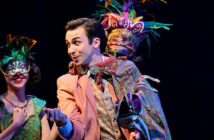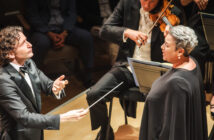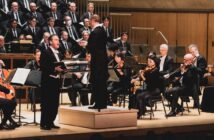Advertisement / Publicité
 SUMMER FESTIVALS 2010
SUMMER FESTIVALS 2010
Bravo! Vail Valley Music Festival
Imagine a music festival that features three of the world’s top orchestras in successive week-long residencies. Throw into the mix the likes of Yo-Yo Ma, Nadja Salerno-Sonnenberg, and Gil Shaham. Shake things up with some of the best conductors at work today: Jaap van Zweden, Alan Gilbert, Charles Dutoit, and Marin Alsop. And don’t forget to add lots of chamber music. Set all this talent up in one of the most spectacular mountain locations you can think of – say, Vail, Colorado – and run your festival for about six weeks. Sounds great, doesn’t it? But of course, who could afford to do it.
That is the question that kept crossing my mind as I sat in my seat at the awkwardly-named Bravo! Vail Valley Music Festival: “How could anyone or any group of people find the money to mount such a festival, especially in the depths of a recession when every arts organization in the country is cutting back or packing it in?” But Bravo! is not a misguided new venture; this festival has been going strong for 23 years. So how do they do it?
It is surely true that Vail must have some of the most dedicated music lovers in the world. It must also be true that these extraordinary music lovers have the financial means to bring their dreams to life.
Classical Music on a Movie Set?
The town of Vail is almost a Disney version of an alpine ski village – charming Swiss chalets bedecked with flower boxes, bustling boutiques, cosy eateries. Since 1962 when it was created, Vail has become an increasingly popular “destination.”
Skiers flock to Vail by the thousands to enjoy some of the best downhill skiing in the world. Après-ski, they gather in their beautifully appointed chalets or in the fine restaurants, bars and upscale stores that abound in the village.
Everything in Vail is carefully managed to maintain the unified Swiss-style, tourist-friendly look. Yes, you will find a McDonald’s here, artfully camouflaged to blend with the alpine character of the buildings and the well-manicured streets. Even cars are controlled in Vail – one doesn’t really need one to get around. The village is compact enough so that one can walk from one end to the other without much effort. For those who are a little less energetic, there is a free shuttle bus that provides an excellent alternative. In the summer, the village and the area’s many mountain paths attract thousands of cyclists and hikers. For those who like some culture with their outdoor activities, there is the Bravo! Vail Valley Music Festival.
Dallas Symphony Bravo’s Opening Orchestral Act
I visited Vail for the opening concerts of Bravo! 2010. I just missed Yo-Yo Ma in recital, but arrived in time to hear the first of six orchestral concerts to be performed by the Dallas Symphony Orchestra (DSO). The DSO will be followed later in the season by the Philadelphia Orchestra and the New York Philharmonic in a similar residency.
One might wonder how the Dallas Symphony gets to share the spotlight with two orchestras generally touted as being in another league – certainly true as far as budgets go!
Among the highlights of the two Dallas Symphony concerts I heard in Vail were the Brahms’ Second Symphony, in which the string playing had a dynamic range and a richness that would be the envy of any orchestra; a high-speed Beethoven Fifth that reflected Maestro van Zweden’s fascination with the Gardiner–Harnoncourt original instrument movement; and an extraordinary interpretation of Barber’s Violin Concerto featuring Nadja-Salerno Sonnenberg.
I have heard Ms. Sonnenberg play this Barber concerto many times with different orchestras and conductors and each time I marvel at how deeply she probes the piece. In Jaap van Zweden, she had not only a friend and former class-mate, but an ideal collaborator. Both she and van Zweden – former concert master of the Royal Concertgebouw Orchestra in The Netherlands – studied with the legendary Dorothy Delay in New York at about the same time and went on to make recordings of the Barber Violin Concerto.
In short, the Dallas Symphony, under Jaap van Zweden, is the equal of many of the finest orchestras in the world. There is, however, another reason why the Dallas Symphony belongs in Vail. This town has long been a favourite getaway destination for Texans: skiing in the winter and cooler and drier weather in the summer. To accommodate these Texas patrons, American Airlines even operates two daily non-stops from Dallas to Vail (actually nearby Eagle County Airport).
Challenges of Outdoor Venues Part of Summer Music Fest Fun!
One always has to make allowances for summer concerts. Even at the best facilities, weather and various distractions are inescapable factors. Vail is no different. The idea is to get away from the formality of winter season concerts in enclosed concert halls, and enjoy the beauties of nature with fine music filling the air. So what if the birds often add their voices to the soundscape (Tanglewood, Ravinia, Vail, etc.)? So what if commuter trains often intrude (Ravinia)? So what if traffic from I-70 sometimes makes its presence felt (Vail)?
The weather is unpredictable everywhere, but this year in Vail (and Aspen) the rains came almost every day, and often just when they could cause the most trouble. Lots of walking is required to get from buses and cars to the Ford Amphitheater in Vail and on the way to our first concert, Marita and I got thoroughly soaked. Fortunately, our seats were under cover – by the end of the concert we were dry again! – but how about those with lawn tickets? The first half-hour of the concert was accompanied by pouring rain! Well, the downpour seemed to be part of the experience for the lawn-folk; most came well-prepared with head to toe raingear and plastic sheets to put under and over themselves. And most seemed to be heartily enjoying the event!
Good Sound, Decent Ticket Prices, Glorious Scenery: Bravo, Vail!
What about the facility itself? It is much smaller than most of the summer concert venues used by the big orchestras – the Atlanta Symphony, for example, recently moved into a new summer home seating 12,000. The Vail facility – The Gerald R. Ford Amphitheater – seats about 1,200 and there is room on the lawn for about 1,200 more. This means that even the folks on the lawn are getting a pretty intimate experience.
The Gerald R. Ford Amphitheater was designed by Morter Architects of Vail and it could be characterized as elegant and graceful. There are five large wood ceiling panels, seemingly floating in air over the stage and audience area, and there are large spaces behind and beside the stage to reveal the ski slopes and trees characteristic of Vail. There does not appear to be much in the design that enhances the acoustics. In fact, executive director John W. Giovando informed me that on-going concern with regard to the acoustics has precipitated discussion of adding a solid back wall to the facility. But in the meantime, the sound system is quite good, and patrons under cover and on the lawn seemed generally pleased with what they were hearing.
I hate to keep coming back to money matters, but money does matter to nearly everything in life. There is no getting around it; the economics of the festival don’t make much sense. I have already mentioned the cost of bringing in large and famous orchestras for weeks at a time. And the venue is too small to generate much revenue. So the ticket prices would have to be astronomical, right? Wrong. For the Dallas Symphony concerts, the top price was a mere $65, very low by either winter or summer standards. Top price at Tanglewood this season is $89 and even higher for special events and at nearby Aspen orchestral concerts are priced at $70 and higher. To be fair, however, one must note that ticket prices for both the Philadelphia Orchestra and New York Philharmonic concerts – which perform at the height of the summer season in Vail – are higher.
Looking at the festival economics from another perspective, we should all be grateful to the folks who live in Vail and who care enough about music to support it for themselves, for their community, and for the tourists who have come to realize that Vail is a unique and magical place, not only in winter but in summer too!
Bravo! Artistic Director Eugenia Zuckerman Plays Mozart
Flutist Eugenia Zukerman has been artistic director of Bravo! Vail Valley Music Festival for the past 13 years and this season she is stepping down. Among her farewell concerts was an appearance as soloist in Mozart’s Flute and Harp Concerto with harpist Yolanda Kondonassis, in a Bravo! concert with the Dallas Symphony, conducted by Jaap van Zweden.
Zukerman is largely responsible for putting together artists and programmes for the six-week festival and by all accounts she has done fine work. She will be succeeded next season by another well-known performer, pianist, Anne-Marie McDermott.
 SUMMER FESTIVALS 2010
SUMMER FESTIVALS 2010













